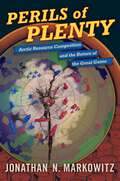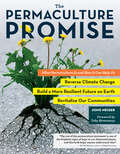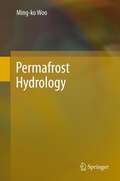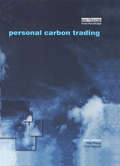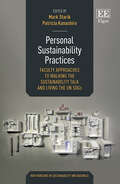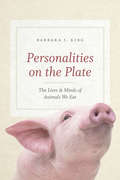- Table View
- List View
Performing the Nonhuman: Towards a Theatre of Transformation (ISSN)
by Conrad AlexandrowiczThis book radically reimagines theatre/performance pedagogy and dramaturgy in response to the accelerating climate crisis.This text is founded upon the principle that the theatre is the most anthropocentric of all the arts: the means of its representation, the human figure, is identical with its conventional object, the human narrative, broadly considered. In order to respond ethically to the climate crisis, it must expand its range to include performing as/in response to the nonhuman. Conrad Alexandrowicz concisely explores theoretical approaches to the other‑than‑human, found in the work of, among others, Jane Bennett, Timothy Morton, Rosi Braidotti, and Cary Wolfe. The implications of this move are far‑reaching and commence with displacing realism from its traditional position of dominance. The practices of 20th century physical theatre visionaries such as Tadeusz Kantor, Jacques Lecoq, and Jerzy Grotowski are revisited and reconsidered for their applicability to forms of theatre that might serve the needs of establishing storytelling deriving from nonhuman phenomena. This logically leads to the matter of responding appropriately to Indigenous ways of knowing and being. The work finds guidance in Indigenous, pre‑scientific ways of knowing and being, such as those articulated by Robin Wall Kimmerer (Braiding Sweetgrass, 2013). In contemplating our kinship with vegetative life, the work finds inspiration in the latest research into the ways tree communities communicate, collaborate, and share resources, including the work of Suzanne Simard (Finding the Mother Tree, 2021). It next imagines transformations in how theatre is situated, delivered, and received and considers the ways in which the performer/spectator binary may have to be reconfigured, with particular reference to Grotowski’s experiments in participatory theatre. It poses an even more provocative question: is such theorized performance work pointing in the direction of some re‑imagined version of ritual and ceremony that may find antecedents in pre‑Christian European belief and practice? Finally, it locates such eco‑theatre in the realm of healing: climate anxiety, depression, and grief on the part of instructors, students, and artists will require us to consider and activate the healing power of the art form; perhaps, the core purpose of all the arts will shift to support the need to generate solace in times of fear, anger, and uncertainty.This book is intended for instructors, both scholars and performance pedagogues, in theatre and performance studies, as well as graduate and undergraduate students in these areas.
Peri-Urban Areas and Food-Energy-Water Nexus: Sustainability and Resilience Strategies in the Age of Climate Change (Springer Tracts in Civil Engineering)
by Angela Colucci Marcello Magoni Scira MenoniThis book explores the nexus among food, energy and water in peri-urban areas, demonstrating how relevant this nexus is for environmental sustainability. In particular it examines the effective management of the nexus in the face of the risks and trade-offs of mitigation policies, and as a mean to create resilience to climate change. The book delineates strategies and actions necessary to develop and protect our natural resources and improve the functionality of the nexus, such as: integrated management of the major resources that characterize the metabolism of a city, stronger coordination among stakeholders who often weight differently the services that are relevant to their individual concerns, integration of efforts towards environmental protection, adaptation to and prevention of climate change and disaster risks mitigation.
Peri-urban Water and Sanitation Services: Policy, Planning and Method
by Mathew Kurian Patricia McCarneyMore than 2.6 billion people in the developing world lack access to safe water and sanitation service. The Millennium Development Goal’s (MDG) target is to halve the number of people without access to a sustainable source of water supply and connection to a sewer network by 2015. That target is unlikely to be met. If there is anything that can be learnt from European experience it is that institutional reform occurs incrementally when politically enfranchised urban populations perceive a threat to their material well-being due to contamination of water sources.
The Perils of Command (John Pearce #12)
by David Donachie1794. Fresh from battle in the Gulf of Ambracia with the villainous Turk Mehmet Pasha, Lieutenant John Pearce and his trusty Pelicans arrive in the Italian port of Brindisi, with captures in tow and his wounded superior, Henry Digby, in a convalescent state. Their landing in the harbour is met by crowds and local dignitaries who insist Digby is attended to by their best physician. Free from authority, Pearce travels to Naples to track down his lover, Emily Barclay.But upon finding her, Emily reveals astonishing news that will send her back to her brutish husband and Pearce’s longstanding enemy, Captain Ralph Barclay, to avoid further scandal. As Pearce sets out for Leghorn to challenge Barclay and persuade him to desist in his pursuit, Barclay hatches his own scheme to thwart the headstrong lieutenant.Faced with bloody sea battles, conspiracies to defeat him and utter chicanery, John Pearce must confront his most dangerous feud yet as his enemies will stop at nothing to see his blood on their swords.
Perils of Plenty: Arctic Resource Competition and the Return of the Great Game
by Jonathan N. MarkowitzAmong scholars who focus on the politics of natural resources, conventional wisdom asserts that resource-scarce states have the strongest interest in securing control over resources. Counterintuitively, however, in Perils of Plenty, Jonathan N. Markowitz finds that the opposite is true. In actuality, what states make influences what they want to take. Specifically, Markowitz argues that the more economically dependent states are on resource extraction rents for income, the stronger their preferences will be to secure control over resources. He tests the theory with a set of case studies that analyze how states reacted to the 2007 exogenous climate shock that exposed energy resources in the Arctic. Given the dangerous potential for conflict escalation in the Middle East and the South China Sea and the continued shrinkage of the polar ice cap, this book speaks to a genuinely important development in world politics that will have implications for understanding the political effects of climate change for many years to come.
PERILS OF PLENTY C: Arctic Resource Competition and the Return of the Great Game
by Jonathan N. MarkowitzAmong scholars who focus on the politics of natural resources, conventional wisdom asserts that resource-scarce states have the strongest interest in securing control over resources. Counterintuitively, however, in Perils of Plenty, Jonathan N. Markowitz finds that the opposite is true. In actuality, what states make influences what they want to take. Specifically, Markowitz argues that the more economically dependent states are on resource extraction rents for income, the stronger their preferences will be to secure control over resources. He tests the theory with a set of case studies that analyze how states reacted to the 2007 exogenous climate shock that exposed energy resources in the Arctic. Given the dangerous potential for conflict escalation in the Middle East and the South China Sea and the continued shrinkage of the polar ice cap, this book speaks to a genuinely important development in world politics that will have implications for understanding the political effects of climate change for many years to come.
Perinatal Physiology
by Uwe StaveLiving Nature, not dull Art Shall plan my ways and rule my heart -Cardinal Newman Nature and Art 1868 One of the ineluctable consequences of growth in any field of science is that subjects of inquiry once established tend to give birth to subsubjects and that the subsubjects once established will in time undergo further mitotic division. Not so many years ago, problems surrounding the ietus and newly born infant lay in a realm almost to be described as a "no-man's land." Obstetricians properly gave major consideration to understanding and learning about processes and disorders concerned with maternal health and safety. The welfare of the infant was regarded as of secondary importance. Pediatricians on their part hesitated to invade the nursery, a sanctum regarded as belonging to the domain of the accoucheur. And the pathologist, enveloped in the mysteries of life and death in the adult, found scant tim~ for the neonate and the placenta.
Perma/Culture: Imagining Alternatives in an Age of Crisis (Routledge Environmental Humanities)
by Molly Wallace and David CarruthersIn the face of what seems like a concerted effort to destroy the only planet that can sustain us, critique is an important tool. It is in this vein that most scholars have approached environmental crisis. While there are numerous texts that chronicle contemporary issues in environmental ills, there are relatively few that explore the possibilities and practices which work to avoid collapse and build alternatives. The keyword of this book’s full title, 'Perma/Culture,' alludes to and plays on 'permaculture', an international movement that can provide a framework for navigating the multiple 'other worlds' within a broader environmental ethic. This edited collection brings together essays from an international team of scholars, activists and artists in order to provide a critical introduction to the ethico-political and cultural elements around the concept of ‘Perma/Culture’. These multidisciplinary essays include a varied landscape of sites and practices, from readings from ecotopian literature to an analysis of the intersection of agriculture and art; from an account of the rewards and difficulties of building community in Transition Towns to a description of the ad hoc infrastructure of a fracking protest camp. Offering a number of constructive models in response to current global environmental challenges, this book makes a significant contribution to current eco-literature and will be of great interest to students and researchers in Environmental Humanities, Environmental Studies, Sociology and Communication Studies.
Perma/Culture: Imagining Alternatives in an Age of Crisis (Routledge Environmental Humanities)
by Molly Wallace David CarruthersIn the face of what seems like a concerted effort to destroy the only planet that can sustain us, critique is an important tool. It is in this vein that most scholars have approached environmental crisis. While there are numerous texts that chronicle contemporary issues in environmental ills, there are relatively few that explore the possibilities and practices which work to avoid collapse and build alternatives. The keyword of this book’s full title, 'Perma/Culture,' alludes to and plays on 'permaculture', an international movement that can provide a framework for navigating the multiple 'other worlds' within a broader environmental ethic. This edited collection brings together essays from an international team of scholars, activists and artists in order to provide a critical introduction to the ethico-political and cultural elements around the concept of ‘Perma/Culture’. These multidisciplinary essays include a varied landscape of sites and practices, from readings from ecotopian literature to an analysis of the intersection of agriculture and art; from an account of the rewards and difficulties of building community in Transition Towns to a description of the ad hoc infrastructure of a fracking protest camp. Offering a number of constructive models in response to current global environmental challenges, this book makes a significant contribution to current eco-literature and will be of great interest to students and researchers in Environmental Humanities, Environmental Studies, Sociology and Communication Studies.
The Permaculture Promise: What Permaculture Is and How It Can Help Us Reverse Climate Change, Build a More Resilient Future on Earth, and Revitalize Our Communities
by Jono NeigerThe Permaculture Promise offers an optimistic, innovative approach to reversing direction and adopting practices that will regenerate, rather than exhaust, Earth&’s resources.
Permafrost Ecosystems: Siberian Larch Forests (Ecological Studies #209)
by Akira Osawa Olga A. Zyryanova Yojiro Matsuura Takuya Kajimoto Ross W. WeinDrawing from a decade-long collaboration between Japan and Russia, this important volume presents the first major synthesis of current knowledge on the ecophysiology of the coniferous forests growing on permafrost at high latitudes. It presents ecological data for a region long inaccessible to most scientists, and raises important questions about the global carbon balance as these systems are affected by the changing climate. Making up around 20% of the entire boreal forests of the northern hemisphere, these ‘permafrost forest ecosystems’ are subject to particular constraints in terms of temperature, nutrient availability, and root space, creating exceptional ecosystem characteristics not known elsewhere. This authoritative text explores their diversity, structure, dynamics and physiology. It provides a comparison of these forests in relation to boreal forests elsewhere, and concludes with an assessment of the potential responses of this unique biome to climate change. The book will be invaluable to advanced students and researchers interested in boreal vegetation, forest ecology, silviculture and forest soils, as well as to researchers into climate change and the global carbon balance.
Permafrost Hydrology
by Ming-ko WooPermafrost Hydrology systematically elucidates the roles of seasonally and perennially frozen ground on the distribution, storage and flow of water. Cold regions of the World are subject to mounting development which significantly affects the physical environment. Climate change, natural or human-induced, reinforces the impacts. Knowledge of surface and ground water processes operating in permafrost terrain is fundamental to planning, management and conservation. This book is an indispensable reference for libraries and researchers, an information source for practitioners, and a valuable text for training the next generations of cold region scientists and engineers.
Permeable Reactive Barrier: Sustainable Groundwater Remediation (Advances in Trace Elements in the Environment)
by Ravi NaiduRemediation of groundwater is complex and often challenging. But the cost of pump and treat technology, coupled with the dismal results achieved, has paved the way for newer, better technologies to be developed. Among these techniques is permeable reactive barrier (PRB) technology, which allows groundwater to pass through a buried porous barrier that either captures the contaminants or breaks them down. And although this approach is gaining popularity, there are few references available on the subject. Until now. Permeable Reactive Barrier: Sustainable Groundwater Remediation brings together the information required to plan, design/model, and apply a successful, cost-effective, and sustainable PRB technology. With contributions from pioneers in this area, the book covers state-of-the-art information on PRB technology. It details design criteria, predictive modeling, and application to contaminants beyond petroleum hydrocarbons, including inorganics and radionuclides. The text also examines implementation stages such as the initial feasibility assessment, laboratory treatability studies (including column studies), estimation of PRB design parameters, and development of a long-term monitoring network for the performance evaluation of the barrier. It also outlines the predictive tools required for life cycle analysis and cost/performance assessment. A review of current PRB technology and its applications, this book includes case studies that exemplify the concepts discussed. It helps you determine when to recommend PRB, what information is needed from the site investigation to design it, and what regulatory validation is required.
Permeable Reactive Barrier: Sustainable Groundwater Remediation (Advances in Trace Elements in the Environment)
by Ravi Naidu Volker BirkeRemediation of groundwater is complex and often challenging. But the cost of pump and treat technology, coupled with the dismal results achieved, has paved the way for newer, better technologies to be developed. Among these techniques is permeable reactive barrier (PRB) technology, which allows groundwater to pass through a buried porous barrier that either captures the contaminants or breaks them down. And although this approach is gaining popularity, there are few references available on the subject. Until now. Permeable Reactive Barrier: Sustainable Groundwater Remediation brings together the information required to plan, design/model, and apply a successful, cost-effective, and sustainable PRB technology. With contributions from pioneers in this area, the book covers state-of-the-art information on PRB technology. It details design criteria, predictive modeling, and application to contaminants beyond petroleum hydrocarbons, including inorganics and radionuclides. The text also examines implementation stages such as the initial feasibility assessment, laboratory treatability studies (including column studies), estimation of PRB design parameters, and development of a long-term monitoring network for the performance evaluation of the barrier. It also outlines the predictive tools required for life cycle analysis and cost/performance assessment. A review of current PRB technology and its applications, this book includes case studies that exemplify the concepts discussed. It helps you determine when to recommend PRB, what information is needed from the site investigation to design it, and what regulatory validation is required.
Personal Carbon Trading
by Tina Fawcett Yael ParagPersonal carbon trading is rapidly moving up the political agenda as recognition grows of its potential to address urgent issues of climate change and natural resource use. Under personal carbon trading schemes a carbon allowance would be allocated to each individual, to be used and traded in the same way as in national and international carbon trading schemes. This volume presents the latest research on personal carbon trading at different scales - from the effects on the individual, communities and organisations, to its place in national, EU (including the EU ETS) and global policy landscapes. It presents key research on the economic and policy barriers and implications, and will be essential reading for anyone involved in emissions trading research or policymaking.
Personal Carbon Trading
by Tina Fawcett Yael ParagPersonal carbon trading is rapidly moving up the political agenda as recognition grows of its potential to address urgent issues of climate change and natural resource use. Under personal carbon trading schemes a carbon allowance would be allocated to each individual, to be used and traded in the same way as in national and international carbon trading schemes. This volume presents the latest research on personal carbon trading at different scales - from the effects on the individual, communities and organisations, to its place in national, EU (including the EU ETS) and global policy landscapes. It presents key research on the economic and policy barriers and implications, and will be essential reading for anyone involved in emissions trading research or policymaking.
Personal Sustainability: Exploring the Far Side of Sustainable Development (Routledge Studies in Sustainability)
by Oliver Parodi Kaidi TammTransition to sustainability is stuck and academic research has not resulted in significant change so far. A large void in sustainability research and the understanding of sustainable development is an important reason for this. Personal Sustainability seeks to address this void, opening up a whole cosmos of sustainable development that has so far been largely unexplored. Mainstream academic, economic and political sustainable development concepts and efforts draw on the macro level and tend to address external, collective and global processes. By contrast, the human, individual, intra- and inter-personal aspects on the micro level are often left unaddressed. The authors of Personal Sustainability invite the reader on a self-reflecting journey into this unexplored inner cosmos of sustainable development, focusing on subjective, mental, emotional, bodily, spiritual and cultural aspects. Although these are intrinsically human aspects they have been systematically ignored by academia. To establish this new field in sustainability research means to leave the common scientific paths and expand the horizon. Together with authors from cultural studies, philosophy, anthropology, psychology, sociology, psychiatry, aesthetics and economics, and supported by contributions from practitioners, this book portrays different approaches to personal sustainability and reflects on their potentials and pitfalls, paving the way to cultures of sustainability. This book will be of great interest to researchers and students in the field of sustainability and sustainable development, as well as researchers from philosophy, anthropology, psychology, sociology, cultural studies, ethnology, educational research, didactics, aesthetics, economics, business and public administration.
Personal Sustainability: Exploring the Far Side of Sustainable Development (Routledge Studies in Sustainability)
by Oliver Parodi Kaidi TammTransition to sustainability is stuck and academic research has not resulted in significant change so far. A large void in sustainability research and the understanding of sustainable development is an important reason for this. Personal Sustainability seeks to address this void, opening up a whole cosmos of sustainable development that has so far been largely unexplored. Mainstream academic, economic and political sustainable development concepts and efforts draw on the macro level and tend to address external, collective and global processes. By contrast, the human, individual, intra- and inter-personal aspects on the micro level are often left unaddressed. The authors of Personal Sustainability invite the reader on a self-reflecting journey into this unexplored inner cosmos of sustainable development, focusing on subjective, mental, emotional, bodily, spiritual and cultural aspects. Although these are intrinsically human aspects they have been systematically ignored by academia. To establish this new field in sustainability research means to leave the common scientific paths and expand the horizon. Together with authors from cultural studies, philosophy, anthropology, psychology, sociology, psychiatry, aesthetics and economics, and supported by contributions from practitioners, this book portrays different approaches to personal sustainability and reflects on their potentials and pitfalls, paving the way to cultures of sustainability. This book will be of great interest to researchers and students in the field of sustainability and sustainable development, as well as researchers from philosophy, anthropology, psychology, sociology, cultural studies, ethnology, educational research, didactics, aesthetics, economics, business and public administration.
Personal Sustainability Practices: Faculty Approaches to Walking the Sustainability Talk and Living the UN SDGs (New Horizons in Sustainability and Business series)
Personal Sustainability Practices is a collection of 19 academic and practitioner perspectives on the topic of faculty personal sustainability. The book addresses the issues of whether, how, where, and when faculty who teach, research, consult, and perform academic and community service are, or need to be, practicing and communicating their own sustainability behaviors to students and other stakeholders. The contributors represent multiple countries, disciplines, academic levels and affiliations, and orientations on those issues and on the 17 United Nations Sustainable Development Goals related to their personal sustainability practices. The chapter contributions highlight the several main concepts of systems, internal and external integration, curriculum development, and social movements. The key takeaway is that many sustainability scholars are practicing and communicating a wide variety of sustainability actions but that greater consistency and frequency among faculty sustainability values, expression, and actions are generally possible and necessary, and that further exploration of this overall topic is encouraged.Current faculty and doctoral students in the field of environmental or socio-economic sustainability, as well as business, government and nonprofit organization executives who interact with said faculty, will be inspired by the examination of values and personal practices.
Personalities on the Plate: The Lives and Minds of Animals We Eat
by Barbara J. KingIn recent years, scientific advances in our understanding of animal minds have led to major changes in how we think about, and treat, animals in zoos and aquariums. The general public, it seems, is slowly coming to understand that animals like apes, elephants, and dolphins have not just brains, but complicated inner and social lives, and that we need to act accordingly. Yet that realization hasn’t yet made its presence felt to any great degree in our most intimate relationship with animals: at the dinner table. Sure, there are vegetarians and vegans all over, but at the same time, meat consumption is up, and meat remains a central part of the culinary and dining experience for the majority of people in the developed world. With Personalities on the Plate, Barbara King asks us to think hard about our meat eating--and how we might reduce it. But this isn’t a polemic intended to convert readers to veganism. What she is interested in is why we’ve not drawn food animals into our concern and just what we do know about the minds and lives of chickens, cows, octopuses, fish, and more. Rooted in the latest science, and built on a mix of firsthand experience (including entomophagy, which, yes, is what you think it is) and close engagement with the work of scientists, farmers, vets, and chefs, Personalities on the Plate is an unforgettable journey through the world of animals we eat. Knowing what we know--and what we may yet learn--what is the proper ethical stance toward eating meat? What are the consequences for the planet? How can we life an ethically and ecologically sound life through our food choices? We could have no better guide to these fascinatingly thorny questions than King, whose deep empathy embraces human and animal alike. Readers will be moved, provoked, and changed by this powerful book.
Personalities on the Plate: The Lives and Minds of Animals We Eat
by Barbara J. KingIn recent years, scientific advances in our understanding of animal minds have led to major changes in how we think about, and treat, animals in zoos and aquariums. The general public, it seems, is slowly coming to understand that animals like apes, elephants, and dolphins have not just brains, but complicated inner and social lives, and that we need to act accordingly. Yet that realization hasn’t yet made its presence felt to any great degree in our most intimate relationship with animals: at the dinner table. Sure, there are vegetarians and vegans all over, but at the same time, meat consumption is up, and meat remains a central part of the culinary and dining experience for the majority of people in the developed world. With Personalities on the Plate, Barbara King asks us to think hard about our meat eating--and how we might reduce it. But this isn’t a polemic intended to convert readers to veganism. What she is interested in is why we’ve not drawn food animals into our concern and just what we do know about the minds and lives of chickens, cows, octopuses, fish, and more. Rooted in the latest science, and built on a mix of firsthand experience (including entomophagy, which, yes, is what you think it is) and close engagement with the work of scientists, farmers, vets, and chefs, Personalities on the Plate is an unforgettable journey through the world of animals we eat. Knowing what we know--and what we may yet learn--what is the proper ethical stance toward eating meat? What are the consequences for the planet? How can we life an ethically and ecologically sound life through our food choices? We could have no better guide to these fascinatingly thorny questions than King, whose deep empathy embraces human and animal alike. Readers will be moved, provoked, and changed by this powerful book.
Personalities on the Plate: The Lives and Minds of Animals We Eat
by Barbara J. KingIn recent years, scientific advances in our understanding of animal minds have led to major changes in how we think about, and treat, animals in zoos and aquariums. The general public, it seems, is slowly coming to understand that animals like apes, elephants, and dolphins have not just brains, but complicated inner and social lives, and that we need to act accordingly. Yet that realization hasn’t yet made its presence felt to any great degree in our most intimate relationship with animals: at the dinner table. Sure, there are vegetarians and vegans all over, but at the same time, meat consumption is up, and meat remains a central part of the culinary and dining experience for the majority of people in the developed world. With Personalities on the Plate, Barbara King asks us to think hard about our meat eating--and how we might reduce it. But this isn’t a polemic intended to convert readers to veganism. What she is interested in is why we’ve not drawn food animals into our concern and just what we do know about the minds and lives of chickens, cows, octopuses, fish, and more. Rooted in the latest science, and built on a mix of firsthand experience (including entomophagy, which, yes, is what you think it is) and close engagement with the work of scientists, farmers, vets, and chefs, Personalities on the Plate is an unforgettable journey through the world of animals we eat. Knowing what we know--and what we may yet learn--what is the proper ethical stance toward eating meat? What are the consequences for the planet? How can we life an ethically and ecologically sound life through our food choices? We could have no better guide to these fascinatingly thorny questions than King, whose deep empathy embraces human and animal alike. Readers will be moved, provoked, and changed by this powerful book.
Personalities on the Plate: The Lives and Minds of Animals We Eat
by Barbara J. KingIn recent years, scientific advances in our understanding of animal minds have led to major changes in how we think about, and treat, animals in zoos and aquariums. The general public, it seems, is slowly coming to understand that animals like apes, elephants, and dolphins have not just brains, but complicated inner and social lives, and that we need to act accordingly. Yet that realization hasn’t yet made its presence felt to any great degree in our most intimate relationship with animals: at the dinner table. Sure, there are vegetarians and vegans all over, but at the same time, meat consumption is up, and meat remains a central part of the culinary and dining experience for the majority of people in the developed world. With Personalities on the Plate, Barbara King asks us to think hard about our meat eating--and how we might reduce it. But this isn’t a polemic intended to convert readers to veganism. What she is interested in is why we’ve not drawn food animals into our concern and just what we do know about the minds and lives of chickens, cows, octopuses, fish, and more. Rooted in the latest science, and built on a mix of firsthand experience (including entomophagy, which, yes, is what you think it is) and close engagement with the work of scientists, farmers, vets, and chefs, Personalities on the Plate is an unforgettable journey through the world of animals we eat. Knowing what we know--and what we may yet learn--what is the proper ethical stance toward eating meat? What are the consequences for the planet? How can we life an ethically and ecologically sound life through our food choices? We could have no better guide to these fascinatingly thorny questions than King, whose deep empathy embraces human and animal alike. Readers will be moved, provoked, and changed by this powerful book.
Perspectives for Biodiversity and Ecosystems (Environmental Challenges and Solutions)
by Carsten HobohmThe novelty of the book is a strong focus on perception, perspectives and prediction by scientists with profound insight into the ecology of ecosystems or into human demands and activity. The challenge is to bridge from empirical data and the knowledge of the past to the possibilities of the performance in the future. We assume that there is scope for more cooperation between the fields of ecology and practical philosophy or other social sciences in organising ecosystems and shaping the cultural future of humankind, and that such collaboration should be accorded considerably more priority. This book deals with environmental processes seen within a framework of the nature of ecosystems and human cultures. The future of the environment, the development of ecosystems and effective nature conservation management are the essentials of this book. Human nature and culture, and in particular their interactions, are interpreted as a set of rules and as given. The aim is not only to assess the significance of human influence on species composition and biodiversity but also to weigh up the subsequent potentials for action. In this book we will analyze the problems independently of one another, even if they are interconnected. This book focuses on perspectives and prognoses for the impacts of anthropogenic activity on ecosystems and thus on species conservation. Its goal is to improve assessments of the impacts of human activity on the environment. We are aware that prognoses have very often proven to be false. It is difficult to impossible to be able to predict with precision how evolution and ecosystems will change in future under anthropogenic influence. This strengthens our resolve to attempt to retain the highest possible degree of scientific integrity and professionalism and not to shy away from expressing the uncertainty of our own ideas and prognoses. We venture prognoses in this book and we will fail. However, we hope that we will be wrong on the right side.
Perspectives in Bioremediation: Technologies for Environmental Improvement (NATO Science Partnership Subseries: 3 #19)
by J. R. Wild S. D. Varfolomeyev A. ScozzafavaBioremediation - the use of microorganisms for environmental clean-up - is a technology that is experiencing a rapid phase of development. From the opening chapter of Perspectives in Bioremediation, on the nature of environmental site assessment, on to the genetic manipulation of native soil microorganisms, the international collection of authors provide an understanding of the current progress and limitations of technologies that are designed to help nature herself. The book draws together many different aspects of environmental remediation: the environmental engineer is introduced to the bacteria of contaminated environments and the ideas developing from genetic engineering; the environmental microbiologist can grasp site assessment and the predictive kinetic analysis of potentials. The book provides a clear and concise introduction to the nature of and potential for bioremediation to contribute to a critical global effort in eliminating contamination of the world's resources and to start to reverse decades of environmental mismanagement and neglect.




